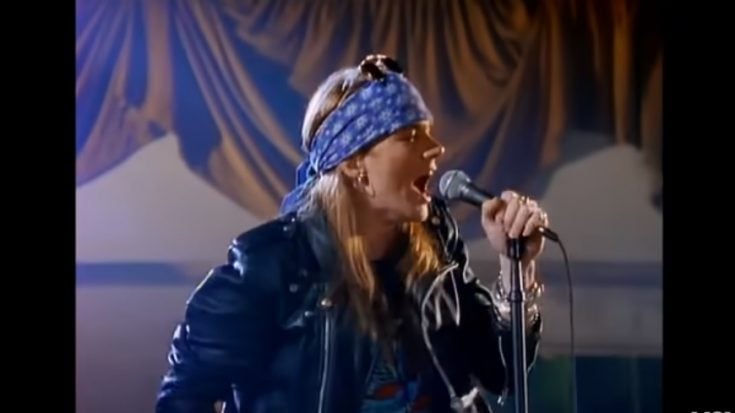10 Hidden Facts About Guns N’ Roses’ “Appetite For Destruction”

Axl Rose and Guns N' Roses in the Sweet Child O' Mine music video - Guns N Roses / Youtube
Love ’em or hate ’em, Guns N’ Roses revolutionized the late 80’s with their explosive debut album, Appetite For Destruction.
Ushering in that satisfying grit and brashness, countering political correctness of the era, Appetite For Destruction showcased the uncanny talent of this ragtag group of rebels to the mainstream. Their long-awaited success, thanks to the chance took by MTV in airing their music, skyrocketed their fame, destroying whatever dregs of rock was in that period, with a homage to classic rock that featured GNR’s own twist. Read on for some facts about this monumental debut album that you might have missed!
A and B-sides, but not quite
While the conventional labeling calls for the A and B-sides of a vinyl or cassette recording, Guns N’ Roses pulled off a nifty marketing stunt that fit their name. They were called the G and R-sides instead, with the G-side containing the “Guns” catalog, for the edgier, heavier tracks, while the R-side, yep, you guessed it, “Roses”, and contained love and relationship-themed songs.
Controversial album cover
The well-known AFD cover, composed of the cross insignia, with the members’ skulls strewn over it, wasn’t the first choice in reality. The now-controversial version by Robert Williams, depicted a robotic rapist with his victim on a ground, with a looming avenger seeking to punish it. This didn’t go well with retailers, so they had to redo the cover, and move the original one into the interior packaging.
Another controversial album cover
Axl Rose revealed in a 2011 interview, that he wanted the featured cover shot of the February 10, 1986 issue of TIME Magazine, to go on the AFD album cover. The problem was, it showed the Space Shuttle Challenger in mid-explosion, which killed seven of its crew. Geffen Records countered him, saying that using the shot would be “in bad taste”.
Viral before it was cool
MTV originally didn’t want to air the music video for “Welcome To The Jungle”, for fear of angering local cable affiliates. It was by the personal request of GNR’s manager Alan Niven to the president of MTV, to allow a single showing at a 5 am Sunday time-slot. Apparently, the video was hot to the viewers, as requests began to flood in for MTV to play the song, making GNR viral even before the Internet was cool.
High risk, high reward
GNR spent two years from its inception, and a whopping $22,000 to prepare the debut of Appetite For Destruction. While some might say it was just change for a band, GNR was just starting off, with the members having no steady source of income, and relying on other people to survive. This paid off later, with AFD raking in 30 million album units sold worldwide, a pretty sweet return for their investment.
Where Do We Go Now?
The catchy line from “Sweet Child O’ Mine” was a moment of serendipity for the band. Producer Spencer Proffer suggested to add lines to the breakdown portion of the song, when a baffled Axl said to himself, “Where do we go? Where do we go now?” Proffer directed him to sing the line, and the rest is history.
Tip-top efficiency
GNR’s iconic guitarist Slash claims that the opening track “Welcome To The Jungle” was written in just three hours, more or less. This was considered efficient, especially when taking into consideration how the track was ranked by VH1 as the greatest hard rock song of all time, in 2009.
Cutting losses early
It wasn’t always rainbows and butterflies for GNR when AFD was launched. Geffen Records were considering to halt promotions of the album and bring GNR back in the studio for a follow-up, after a dismal 200,000 sold copies in the initial months of its release. The band miraculously bounced back after a year, when the album suddenly topped the charts, creating an influx of demand for their material.
The Real Rocket Queen
People mostly know “Rocket Queen” for its inclusion of sexual moans by Adriana Smith, who was Steven Adler’s girlfriend at the time, after seeking revenge upon knowing of Adler cheating on her. Smith became dubbed as the Rocket Queen for her participation, but there was a real Rocket Queen, to whom Axl Rose dedicated the song to. Barbie Von Grief, longtime friend of Rose, took him in in their early days and helped him survive. Rose, in gratitude and love, wrote the song, taking the song’s title from Von Grief’s own band.
Give credit where it’s due
There are only two people who were given writing credits for Appetite For Destruction, who weren’t band members themselves. West Arkeen, who co-wrote “It’s So Easy”, was considered as GNR’s sixth man by Axl Rose, while Chris Weber, who co-wrote “Everything Goes”, was a former bandmate of Axl and Izzy from their time in Hollywood Rose.











